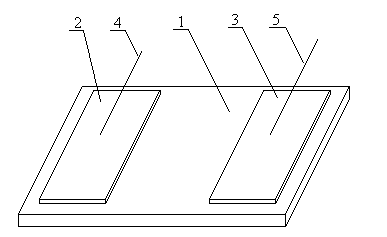Environmental energy conversion device
A technology of energy conversion and environment, applied in measuring devices, using electrical devices, measuring heat, etc., can solve problems such as discontinuous electrical output, large volume and weight, and disorder.
- Summary
- Abstract
- Description
- Claims
- Application Information
AI Technical Summary
Problems solved by technology
Method used
Image
Examples
Embodiment 1
[0053] Such as figure 1 As shown, the environmental energy conversion device includes an energy conversion unit. The energy conversion unit includes an intermediate 1 , a positive electrode 2 and a negative electrode 3 . The intermediate 1 is connected to the positive electrode 2 and the negative electrode 3 , and is sandwiched between the positive electrode 2 and the negative electrode 3 . The intermediate body 1, the positive electrode 2, and the negative electrode 3 are installed on the substrate 6, and the positive electrode 2 and the negative electrode 3 are placed in parallel with a certain distance between them. The intermediate body sandwiched in the middle includes a contact surface with the outside world. For contact with intermediate media. The positive pole 2 is connected with a positive pole lead 4 , and the negative pole 3 is connected with a negative pole lead 5 . In order to avoid contact between the positive electrode 2 and the negative electrode 3 and the ...
Embodiment 2
[0055] Referring to Example 1, different from Example 1, the semiconductor of the intermediate 1 of the energy conversion unit is a bulk material, thus the substrate 6 is missing, such as image 3 shown.
Embodiment 3
[0057] Referring to Example 2, the positive pole 2 and the negative pole 3 of the energy conversion unit adopt an asymmetric layout, such as Figure 4 As shown, the positive electrode 2 and the negative electrode 3 include a cross structure. Wherein, the contact area between the positive electrode 2 and the intermediate body 1 is smaller than the contact area between the negative electrode 3 and the intermediate body 1 .
PUM
| Property | Measurement | Unit |
|---|---|---|
| internal resistance | aaaaa | aaaaa |
| internal resistance | aaaaa | aaaaa |
| thickness | aaaaa | aaaaa |
Abstract
Description
Claims
Application Information
 Login to View More
Login to View More - Generate Ideas
- Intellectual Property
- Life Sciences
- Materials
- Tech Scout
- Unparalleled Data Quality
- Higher Quality Content
- 60% Fewer Hallucinations
Browse by: Latest US Patents, China's latest patents, Technical Efficacy Thesaurus, Application Domain, Technology Topic, Popular Technical Reports.
© 2025 PatSnap. All rights reserved.Legal|Privacy policy|Modern Slavery Act Transparency Statement|Sitemap|About US| Contact US: help@patsnap.com



